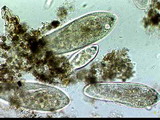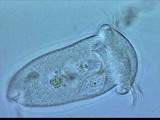The Other Bacteria...
Free Swimming and Stalked Ciliates...
Identification : The Ciliates are more complex organisms than the amoebae and flagellates. Over 7,000 known
species exist of some of the most complex single-celled organisms ever. Free swimming ciliates are covered with cilia,
hair-like projections, which are uniform and aligned in rows. The ciliates move and capture food by means of the cilia.
The anterior portion of the ciliate is the oral region which is also covered with cilia. Free swimming ciliates range
in size from 20-400 µm and have two kinds of nuclei. Sexual reproduction is by conjugation. Free-swimmers swim faster
than flagellates so they can out compete them for food. Ciliates feed on bacteria not on dissolved organics. While
bacteria and flagellates compete for dissolved organics, ciliates compete with other ciliates and rotifers for bacteria.
They are usually an indicator of good quality sludge. They are typically found in young to medium age sludge.
Additional Information :Free swimming ciliates are protozoa that are in the phylum Ciliophora. Many different
types of free swimming ciliates exist, including "crawling" ciliates`. Some types commonly found in wastewater are
Paramecium, Euplotes, and Aspidisca.
Crawling ciliates have cilia mainly on the lower surface of their bodies that make them appear to be legs. These are
organisms with compound ciliary organelles called cirri used to walk on. They are usually dorsoventrally flattened.
Common types found in wastewater are the Genus : Aspidisca and Genus : Euplotes. In order for crawling ciliates to be
dominant, there must be large floc structures present that impede the free-swimmers and flagellates movement and provide
a surface for the crawlers to "walk" on. This means the F:M is getting lower and the bacteria have started to formulate
floc structures. Crawlers also require a high D.O. content in the mixed liquor. Sludge age is closer to middle ages than
young. Crawling ciliates usually indicate a stable wastewater environment and a healthy sludge.
Where Found :They are found in various types of water, including freshwater and wastewater. Free swimming
ciliates are important because they work with the bacteria. They feed on the bacteria and thus help to clarify the
effluent. These can be found during most sludge ages but are dominant during the middle sludge ages.
How to Find Them :Microscopic examination of a wet mount.
Pics of Free Swimming Ciliates...

Pics of Stalked Ciliates...











